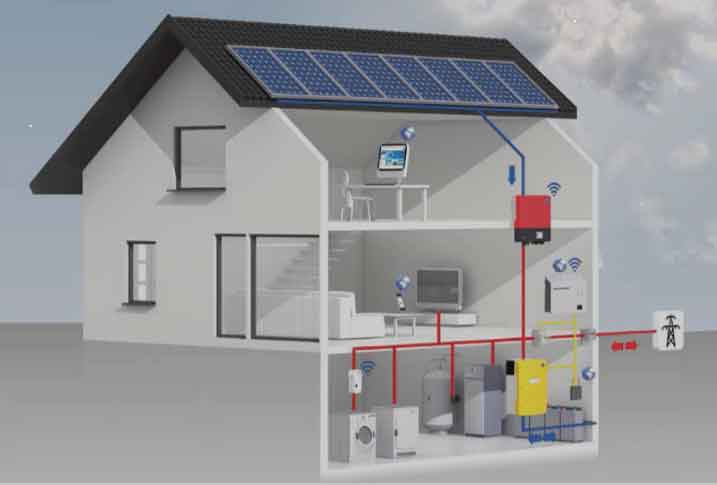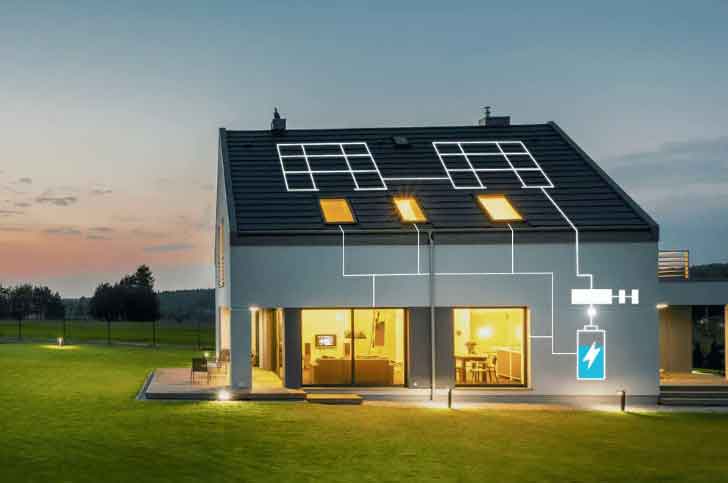Basic Principle of Solar Battery for House
The working principle of a solar battery, also known as a solar panel or photovoltaic (PV) cell, is based on the photovoltaic effect. This effect allows sunlight to be directly converted into electricity using semiconductor materials. Here’s a breakdown of the process:
- Semiconductor Material: Solar panels are made up of semiconductor materials, usually silicon. Silicon has unique electronic properties that make it suitable for capturing and converting solar energy.
- Absorption of Photons: When sunlight (composed of photons) strikes the surface of a solar panel, these photons carry energy. The semiconductor material in the panel absorbs these photons.
- Excitation of Electrons: The absorbed energy from photons excites electrons in the semiconductor material, causing them to move from their normal state to a higher energy state.
- Generation of Electron-Hole Pairs: The energy from the absorbed photons creates “electron-hole pairs.” An electron is excited to a higher energy level, leaving behind a positively charged “hole” in its original position.
- Electric Field Formation: The semiconductor material is intentionally engineered with two different layers: an n-type layer (with an excess of electrons) and a p-type layer (with a deficit of electrons or excess of holes). This creates an electric field at the junction between these layers, known as the p-n junction.
- Electron Movement: Due to the electric field, the excited electrons are pushed towards the n-type layer, while the holes move towards the p-type layer. This movement creates an imbalance of charges between the two layers.
- Generation of Voltage: The movement of charges due to the electric field creates a voltage difference across the p-n junction. This voltage difference is what enables the solar cell to produce electricity.
- Electric Current: If an external circuit is connected to the solar cell, the separated charges (electrons and holes) flow through the circuit to recombine at the opposite side of the solar cell, thus generating an electric current.
- Direct Current (DC) Output: The generated electric current is in the form of direct current (DC), which is the type of electricity commonly used in household appliances and electronics.
- Inverter for AC Conversion: Most household appliances and the electrical grid operate on alternating current (AC). To use the electricity generated by the solar panels in your home, it needs to be converted from DC to AC using an inverter.
Solar panels work by harnessing the photovoltaic effect, which involves the absorption of photons by semiconductor materials, the excitation of electrons, and the subsequent generation of an electric current due to the movement of these excited charges. This process allows solar panels to directly convert sunlight into usable electricity for your house.
Materials for Solar Battery for House

The different types of solar cells commonly used for residential solar battery systems:
- Monocrystalline Silicon Solar Cells:
- Monocrystalline cells are made from a single crystal structure, which results in higher efficiency due to the uniformity of the material.
- They have a high power conversion efficiency, typically around 15-22%, making them efficient in converting sunlight into electricity.
- They require less space compared to other types, making them ideal for installations with limited space.
- Monocrystalline panels tend to be more expensive due to the manufacturing process and higher efficiency.
- Polycrystalline Silicon Solar Cells:
- Polycrystalline cells are made from multiple crystals, which can result in lower efficiency compared to monocrystalline cells.
- They are generally more affordable to produce than monocrystalline cells, making them a cost-effective option.
- Polycrystalline panels are slightly less efficient than monocrystalline panels, with typical efficiency ranging from 13-16%.
- Amorphous Silicon Solar Cells:
- Amorphous silicon cells are non-crystalline and can be deposited as thin films on various substrates.
- They are less efficient compared to crystalline silicon cells, with efficiency typically in the range of 6-10%.
- Amorphous silicon cells have the advantage of being flexible, which can allow for creative installation options and integration into various surfaces.
- Thin-Film Solar Cells (CIGS, CdTe, etc.):
- These types of cells use thin layers of semiconductor material and can be more cost-effective to produce than crystalline silicon cells.
- Copper Indium Gallium Selenide (CIGS) and Cadmium Telluride (CdTe) are common materials used in thin-film solar cells.
- Thin-film cells have lower efficiency compared to crystalline silicon cells, ranging from 9-13%, but they can perform better in low light conditions and high temperatures.
- Organic Solar Cells:
- Organic solar cells use organic materials that can be lightweight and flexible.
- They have lower efficiency compared to other types of solar cells, typically in the range of 3-5%.
- Organic solar cells are still under development and hold promise for applications where traditional solar panels are impractical.
- Perovskite Solar Cells:
- Perovskite solar cells are an emerging technology with rapidly improving efficiency levels.
- They are made using a unique crystal structure and have shown the potential for high efficiency, potentially rivaling traditional silicon cells.
- Research and development in perovskite solar cells are ongoing to address stability and scalability challenges.
The choice of solar cell material depends on factors such as efficiency, cost, available space, and aesthetic preferences. Monocrystalline and polycrystalline silicon cells are among the most widely used for residential solar installations due to their established efficiency and reliability. Thin-film and emerging technologies like perovskite cells offer exciting possibilities for the future of solar energy.
Energy Storage Technology of Solar Battery for House

Energy storage technologies play a crucial role in enhancing the efficiency and reliability of solar energy systems for households. Here’s an overview of some common energy storage technologies used in solar battery systems:
- Lithium-Ion Batteries:
- Lithium-ion batteries are widely used due to their high energy density, efficiency, and relatively long cycle life.
- They are commonly used in various applications, including electric vehicles and residential energy storage.
- Lithium-ion batteries provide fast response times, making them suitable for applications like load shifting and backup power.
- Their performance and lifespan can vary based on factors like depth of discharge (DoD), temperature, and charging/discharging rates.
- Safety concerns include thermal runaway and fire risks, which are mitigated through proper battery management systems and designs.
- Flow Batteries:
- Flow batteries store energy in liquid electrolytes contained in separate tanks, which can allow for flexible energy capacity adjustments.
- They have potentially longer lifespans due to the separation of the energy storage medium from the electrodes.
- Flow batteries are often used in larger-scale applications, and their efficiency and performance can be influenced by factors like the type of electrolyte used.
- They may be more suitable for applications that require frequent deep cycling.
- Lead-Acid Batteries:
- Lead-acid batteries are one of the oldest and most established energy storage technologies.
- They are cost-effective but have lower energy density and shorter lifespans compared to lithium-ion batteries.
- Lead-acid batteries are used less frequently in residential solar systems due to these limitations.
- Saltwater Batteries:
- Saltwater batteries use saltwater electrolytes instead of traditional chemical components, which can make them safer and more environmentally friendly.
- They offer relatively long cycle life, high energy efficiency, and are non-toxic.
- Saltwater batteries are gaining attention as a viable option for residential energy storage.
- Hybrid Systems:
- Some systems combine different types of batteries or energy storage technologies to optimize performance and address specific use cases.
- For example, combining lithium-ion batteries for fast response with flow batteries for longer-duration storage.
When considering an energy storage system for a solar-powered house, several factors should be taken into account:
- Performance: Assess the system’s efficiency, energy density, charge/discharge rates, and response time to ensure it meets your energy needs.
- Lifespan: Consider the expected lifespan of the battery technology, usually measured in cycles. Lithium-ion batteries can typically handle hundreds to thousands of cycles.
- Safety: Evaluate the safety features of the technology, including thermal management, overcharge/overdischarge protection, and containment mechanisms.
- Optimization: Proper system sizing and design are crucial to optimize the utilization of solar energy. Batteries should be sized to balance daily energy requirements and solar generation.
- Maintenance: Different technologies have varying maintenance requirements. Lithium-ion batteries generally require less maintenance compared to lead-acid batteries.
- Cost: Factor in the initial cost of the system, ongoing maintenance costs, and potential savings from reduced energy bills and incentives.
- Environmental Impact: Consider the environmental impact of the battery technology, including the materials used and disposal/recycling options.
Choosing the right energy storage technology depends on your specific needs, budget, and local conditions. Consulting with solar and energy storage professionals can help you make an informed decision tailored to your situation.
